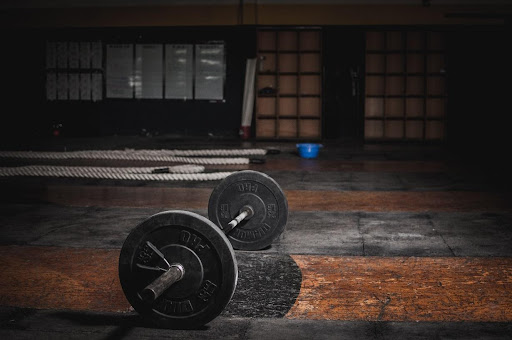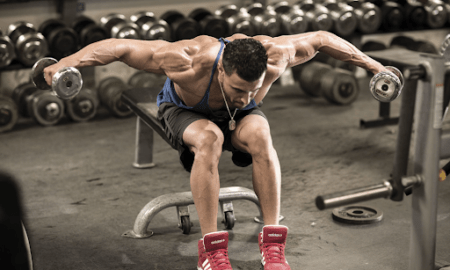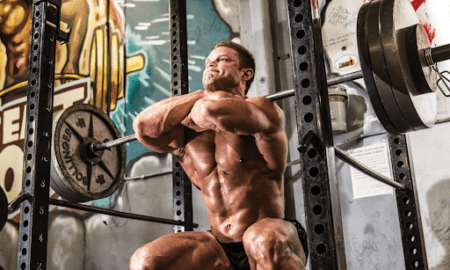

How long has it been since you last pumped iron? Lifting is one of the ways you can improve strength, endurance, stability, and explosive speed, apart from also enhancing your physique and athletic performance.
When it comes to bodybuilding, the possibilities are endless. However, no athlete can simply pick weights and expect an instantaneous transformation. It is helpful to understand that workouts need to be structured correctly for optimal outcomes.
So, read thoroughly to get some helpful training guides, safety tips, and more on how to exercise for mass increase.
How To Correctly Train To Avoid Injury
Progressively lifting weights makes muscles robust. Physiologically, repetitive training promotes the release of neurohormonal mediates that enhance the growth of muscles.
But while strength training will possibly improve your performance, it inherently exposes your muscles to strain and pressure. Here are some tips to keep your full body session safe and productive.
- Warm up and cool down. Get your body ready to exercise by always warming up and increasing the supply of oxygen and nutrient-rich blood to joints and muscles. On the other hand, stretching keeps muscles flexible and improves the elimination of toxic lactate.
- Perfect your form. A common cause of injury in the gym is executing workouts improperly. To reduce the risk of injury, first, get used to the range of motion for each exercise. Besides, there is nothing wrong with training without weights (or using light resistance) while building your form. Concentrate on each section of the routine, making sure that you nail the movement, and when your muscles and joints can handle the pressure, progress to lifting heavier weights.
- Listen to your body. As earlier said, strength training exposes the body to strain and pressure. Therefore, there is no need to put yourself at risk if you have preexisting mobility issues. Many routines can aggravate pre-existing illnesses and possibly cause complications. First, talk to your primary health care provider before doing some of these exercises. Better safe than sorry.
- Challenge your muscles by optimizing the resistance. Choose a suitable weight based on the exercise and your form. Understand that there is no clear-cut way about the selection of weight. However, the tradition is to pick weights that leave you exhausted during the end of a set but still have enough energy to complete it in perfect form. Without saying, if you breeze through a set without tiring, it means you should add more weight (around 2 pounds for arms and 5 pounds for the lower body) unless you are executing high-rep endurance workouts.
- Stick to the routine. A full-body workout targeting significant muscles of your body is ideal two to three times each week. You can have a standalone routine for the whole body or break it into upper and lower body components. However, the bottom-line for each case is to stick to the pattern and build muscle memory.
- Give muscles some time off. Weightlifting causes microscopic tears to muscles. These aren’t harmful but are essential for muscle growth. Muscles grow when additional protein substance is deposited in these areas. Therefore, give your muscles adequate time to remodel and repair before the next training session.
How To Create An Effective Session
The ideal rep range in lifting exercises is between 10-15 reps depending on the movement. While you will want to execute each rep to perfection, you should also give your muscles a deserved recovery at the end of each set.
For example, you may hit 12 squats nonstop and then rest for two to three minutes between sets. By this system, your muscles are optimally stimulated and given ample time to recover and avoid lactic acid buildup. If you systematically structure your workouts, sessions will last anywhere between 45 minutes to one hour.
The Benefits Of Full-Body Workouts
Here are some of the reasons why full-body workouts are beneficial to your training:
- More time for other activities. Remember that full-body routines only require a day or two in the gym. Meaning that you’ll get more time for additional activities such as cycling, swimming, walking, running, and cardio training, especially during rest days.
- Better muscle recovery. Fitness is highly individualized, and it is OK if you cannot visit the gym all days of the week. Having said that, the basis of full-body workouts is having two or three workout days each week. Rest days facilitate the recovery of muscles after strenuous exertion and keep in mind that muscles grow best when they are given adequate rest.
- Flexible time commitment. If you are the type of person who is always occupied and cannot find the time to visit the gym each day, then a full-body workout is the solution. Full-body exercises are done twice or thrice each week, and they are ideal if you have a busy lifestyle.
- Suitable for maintaining lean muscle mass. If you want to lose weight, toss in full-body routines. When you are on a bulking pattern, your daily calorie surplus is used during workouts which means you break down more fat resulting in less fat reserves. Notwithstanding, the process is also coupled with muscle growth and is thus ideal for keeping you lean and fit.
Circuit options
To see the full benefits of full-body workouts, you must follow a systematic format. Your routine will have diverse workouts combining isolation and compound movements depending on your goals and objectives.
Here are some full-body circuit options you can try out today:
Circuit one
Squat clean
Beginner: 3 sets of 6 reps
Intermediate: 3 sets of 6-10 reps
Advanced: 3 sets of 8-12 reps
Seated calf raises
Beginner: 3 sets of 10-15 reps
Intermediate: 3 sets of 15-20 reps
Advanced: 3 sets of 20+ reps
Goblet squat
Beginner: 3 sets of 8-12 reps
Intermediate: 3 sets of 12-15 reps
Advanced: 4 sets of 12-15 reps
Bench press
Beginner: 3 sets of 8 reps
Intermediate: 3 sets of 8-10 reps
Advanced: 4 sets of 8-10 reps
Bent over row
Beginner: 3 sets of 6-10 reps
Intermediate to advanced: 3-4 sets of 8-12 reps
Lat pulldown
Instruction: Adjust resistance to your ideal range and do 3 sets of 10-15 reps
Cable crunch
Tip: 3 reps of 10-15 reps under the suitable resistance
Hip thrust
Beginner: 3 sets of 8-12 reps
Intermediate: 3 sets of 12-15 reps
Advanced: 4 sets of 12-15 reps
Circuit two
Deadlift
Beginner: 3 sets of 6 reps
Intermediate: 3-4 sets of 5 reps
Advanced: 5 sets of 5 reps
Front squat
Beginner: 3 sets of 6 reps
Intermediate to advanced: 3-4 sets of 6 reps
Arnold press
Beginner: 3 sets of 10-12 reps
Intermediate to advanced: 3-4 sets of 10-15 reps
Bench dip
Beginner: 3 sets of 8-12 reps
Intermediate: 3 sets of 12-15 reps
Advanced: 4 sets of 12-15 reps
Cable crossover
All fitness levels: 3 sets of 8-12 reps.
Tip: Adjust the resistance to a comfortable range depending on your form.
Single leg calf raises
Beginner: 3 sets of 10-15 reps
Intermediate: 3 sets of 15-20 reps
Advanced: 4 sets of 20=+ reps
Cable with lateral raises
Beginner: 3 sets of 10 reps
Intermediate to advanced: 3-4 sets of 12-15 reps
Leg extension
Training instruction: Use a suitable weight range and execute 3 sets of 8-12 reps
Circuit three
Push jerk
Training tip: 3-4 sets of 5-6 reps
Standing overhead press
Beginner to intermediate: 3-4 sets of 6 reps
Advanced: 5 sets of 6 reps
Dumbbell lunge
Beginner to intermediate: 2-3 sets of 8-15 reps
Advanced: 4 sets of 12-15 reps
Pullups
Beginner: 3 sets of 6-8 reps
Intermediate: 3 sets of 8-12 reps
Advanced: 4 sets of 10-12 reps
Barbell shrug
Beginner: 3 sets of 12-15 reps
Intermediate to advanced: 4-5 sets of 15-20 reps
Hip thrust
Beginner: 3 sets of 8-12 reps
Intermediate: 3 sets of 12-15 reps
Advanced: 4 sets of 12-15 reps
Battle ropes
Training tip: 3 sets of 12 reps

Dumbbell crunch
Tip: Choose the ideal weight and complete 2-3 sets of 10-15 reps
The Best Diet To Gain Mass
Bodybuilding depends on both what you do inside and outside the gym. To get the most out of your time in the gym, you must fine-tune your diet to maintain lean muscle growth.
Note that there are two phases of muscle growth which we’ll explain:
First, you go through an extensive bulking phase (for several months to years), hallmarked by increased muscle mass. Bodybuilders in this phase should consume calorie and protein-dense diets to build as much muscle as possible.
In the second phase, also known as the cutting stage, the main objective is to eliminate residual body fat and consolidate the bulking phase, which typically spans 12-26 weeks.
So, how much protein and calories do you need?
There are two bodybuilding phases, the exact requirements are tweaked to fit each stage.
It would help if you had a 15% surplus of calories above your maintenance input during the lifting phase. For example, if the daily requirement is 2000 calories, top it up with 300 calories. You also decrease your daily intake by 15% as you transition to the cutting phase. If you need 2000 calories, reduce your intake by the same measure.
However, the guiding measure in each phase is your weight – you should not lose or gain more than 0.5% – 1 % of your weight.
Final Take:
A complete bodybuilding program can develop the athletic performance of beginner and advanced enthusiasts alike.
Workouts can have between 8-12 reps based on individual form and abilities, but the basis is to adapt reps and sets to your liking. In the end, every program should be practical and undertaken with continuous improvement in mind.























You must be logged in to post a comment Login